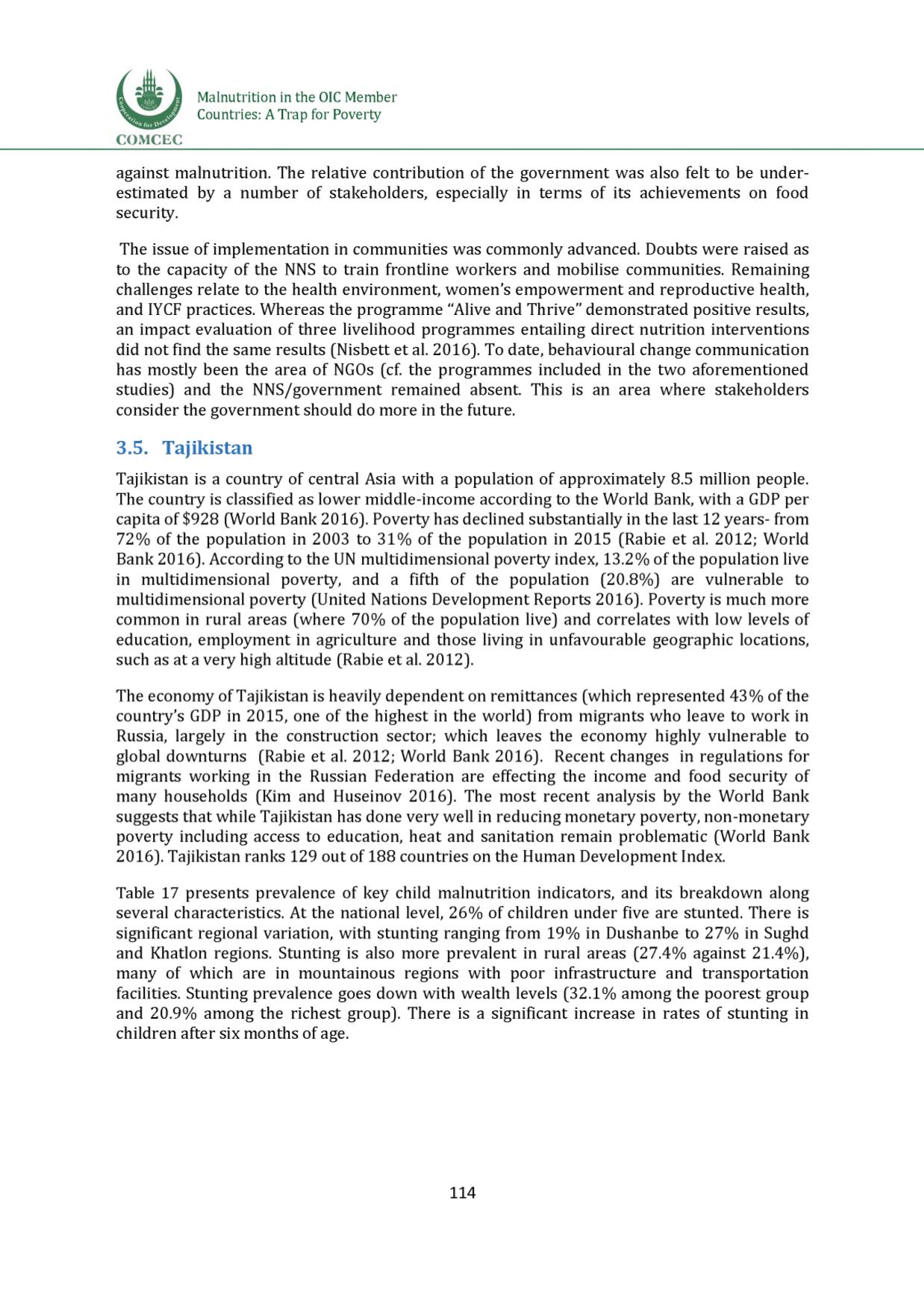

COMCEC
Malnutrition in the OIC Member
Countries: A Trap for Poverty
against malnutrition. The relative contribution of the government was also felt to be under
estimated by a number of stakeholders, especially in terms of its achievements on food
security.
The issue of implementation in communities was commonly advanced. Doubts were raised as
to the capacity of the NNS to train frontline workers and mobilise communities. Remaining
challenges relate to the health environment, women's empowerment and reproductive health,
and IYCF practices. Whereas the programme “Alive and Thrive” demonstrated positive results,
an impact evaluation of three livelihood programmes entailing direct nutrition interventions
did not find the same results (Nisbett et al. 2016). To date, behavioural change communication
has mostly been the area of NGOs (cf. the programmes included in the two aforementioned
studies) and the NNS/government remained absent. This is an area where stakeholders
consider the government should do more in the future.
3.5. Tajikistan
Tajikistan is a country of central Asia with a population of approximately 8.5 million people.
The country is classified as lower middle-income according to the World Bank, with a GDP per
capita of $928 (World Bank 2016). Poverty has declined substantially in the last 12 years- from
72% of the population in 2003 to 31% of the population in 2015 (Rabie et al. 2012; World
Bank 2016). According to the UNmultidimensional poverty index, 13.2% of the population live
in multidimensional poverty, and a fifth of the population (
2 0
.
8
%) are vulnerable to
multidimensional poverty (United Nations Development Reports 2016). Poverty is much more
common in rural areas (where 70% of the population live) and correlates with low levels of
education, employment in agriculture and those living in unfavourable geographic locations,
such as at a very high altitude (Rabie et al. 2012).
The economy of Tajikistan is heavily dependent on remittances (which represented 43% of the
country's GDP in 2015, one of the highest in the world] from migrants who leave to work in
Russia, largely in the construction sector; which leaves the economy highly vulnerable to
global downturns (Rabie et al. 2012; World Bank 2016). Recent changes in regulations for
migrants working in the Russian Federation are effecting the income and food security of
many households (Kim and Huseinov 2016). The most recent analysis by the World Bank
suggests that while Tajikistan has done very well in reducing monetary poverty, non-monetary
poverty including access to education, heat and sanitation remain problematic (World Bank
2016). Tajikistan ranks 129 out of 188 countries on the Human Development Index.
Table 17 presents prevalence of key child malnutrition indicators, and its breakdown along
several characteristics. At the national level, 26% of children under five are stunted. There is
significant regional variation, with stunting ranging from 19% in Dushanbe to 27% in Sughd
and Khatlon regions. Stunting is also more prevalent in rural areas (27.4% against 21.4%),
many of which are in mountainous regions with poor infrastructure and transportation
facilities. Stunting prevalence goes down with wealth levels (32.1% among the poorest group
and 20.9% among the richest group). There is a significant increase in rates of stunting in
children after six months of age.
114
















